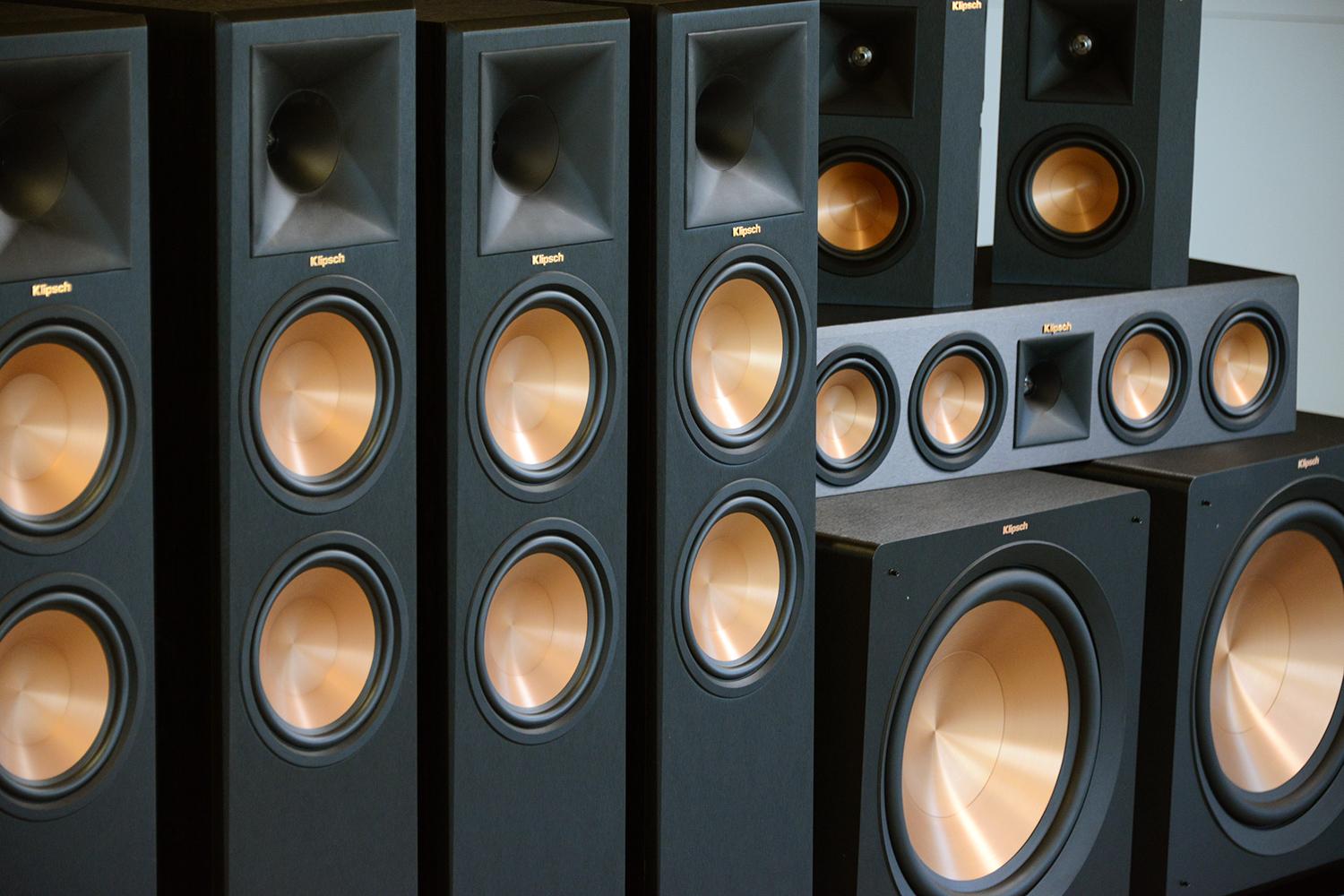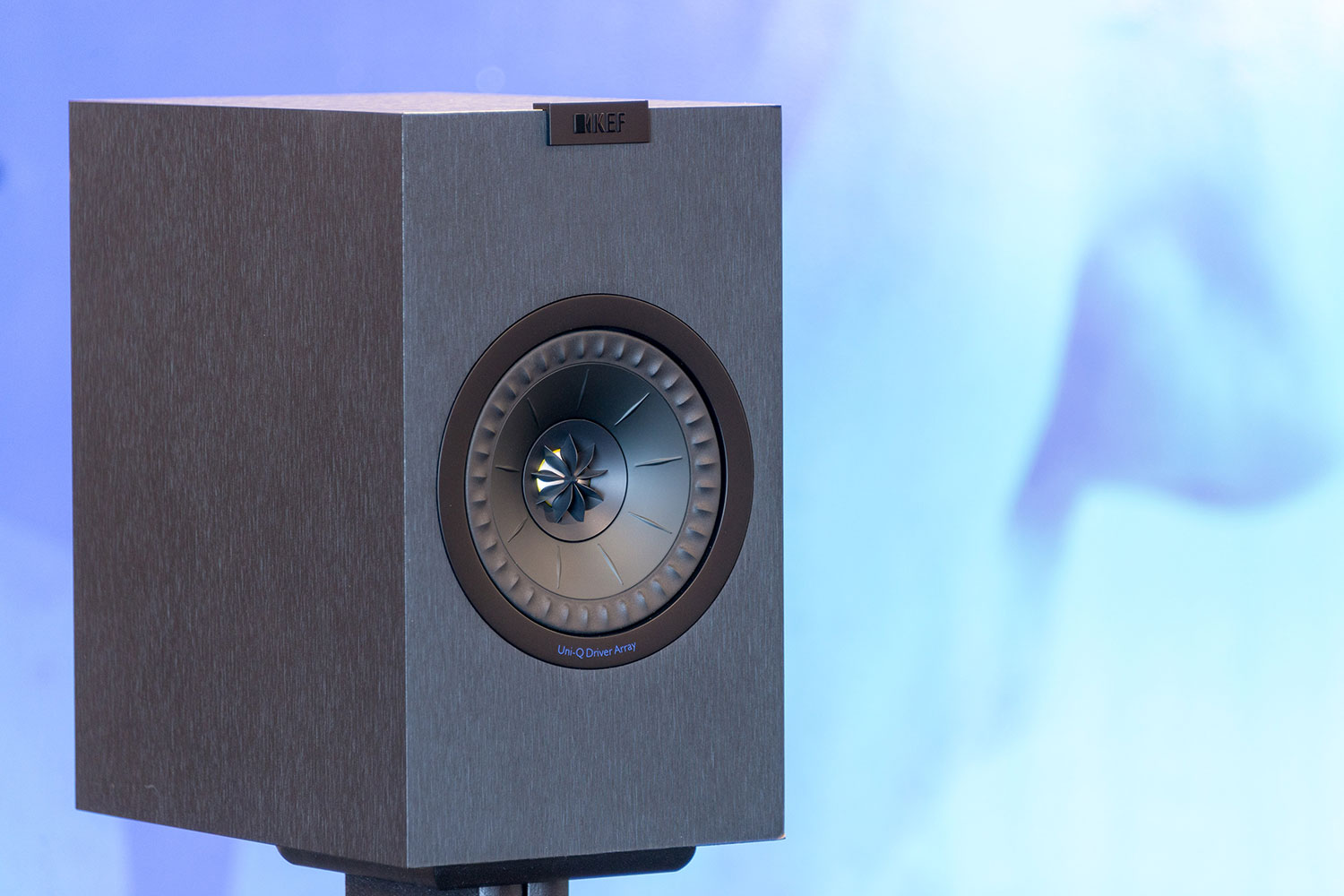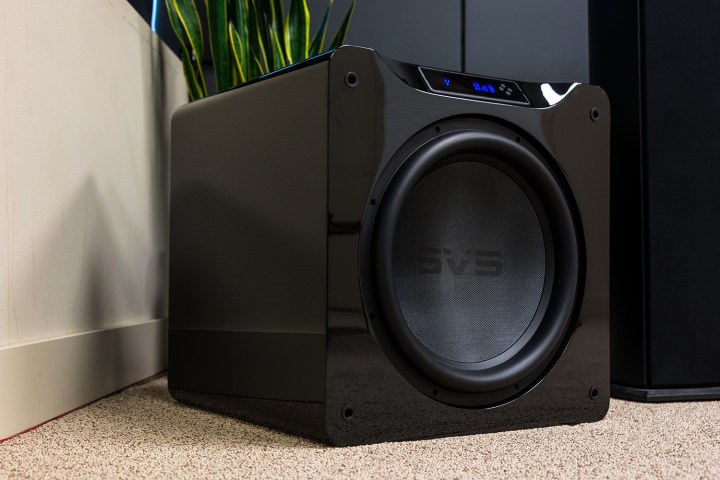
Whether you’re looking to upgrade from the thin sound coming out of your new TV or you simply want to listen to your favorite tunes in all their glory, shopping for speakers can be a humbling experience for even the audio savvy among us.
Not only are there budget considerations, but there are just so many different types of speakers available, from wireless wonders that work in tandem over Wi-Fi to traditional wired speakers in of all shapes and sizes, all available in a litany of form factors, models, and configurations. This guide will not only walk you through the main available options but also outline each speaker type’s most prized aptitudes and applications so you can narrow the field and pick what’s right for you.
Note: This list does not include portable speakers or smart speakers. For more information on those, please follow the links provided.
Floorstanding speakers
As the name implies, these speakers are meant to sit on the floor in your listening room and barrel out big sound. Also known as tower speakers, these options typically include multiple drivers along with one or more tweeters, allowing them to cover a wide range of frequencies. If this recalls gigantic speakers from the 1970s, you might be surprised at today’s designs. Modern floorstanding speakers can be big, but you’ll also find them in multiple slim varieties that have a relatively small footprint.
You’ll often see these speakers in more elaborate home theater setups, and they remain the preferred speaker type for listening to music (though studio engineers may point to high-end bookshelf speakers instead). The range of prices for these speakers is wide — while you’ll find models for less than $100 per speaker, higher-end models can cost thousands or even tens of thousands.
Many floorstanding speakers cover enough of the frequency spectrum that you won’t need a subwoofer, but the trade-off here is that they’re generally going to be bigger. For most listeners, there’s a choice to be made between larger towers and no subwoofer, or slimmer, shorter towers along with a subwoofer to add additional power to the low end. Floorstanding speakers designed for premium sound deserve equally premium power, so budget enough for a nice A/V receiver or amplifier to unleash everything the speakers are capable of.
Bookshelf speakers
This is another type of speaker where the name pretty much describes the design. The smaller sibling to floorstanding speakers, bookshelf speakers sound best when their tweeters are positioned at ear level — about 38 — 41 inches from the floor — which will require speakers stands, but many end up taking advantage of their compact size and placing them on a bookshelf or some other piece of furniture. Most bookshelf speakers sport one woofer — usually around 5.25 inches in diameter — and a one-inch tweeter in a two-way configuration, though some, like ELAC’s Uni-fi UB5, offer a trio of drivers in a three-way crossover configuration. While they don’t pack quite as much punch as floorstanding speakers, you’ll still get plenty of sound out of a quality pair of bookshelf speakers.

Many bookshelf speakers offer enough bass response for music listening, though anyone building a home theater setup (and fans of big bass) will want to add a subwoofer. Because bookshelf speakers are smaller, you might think they require less power than floorstanding speakers, but that isn’t always the case — some bookshelf speakers can actually be more power hungry than sensitive floorstanding speakers. A good rule of thumb is to feed your speakers with the highest quality power you can. A great amp will make an average speaker sound great, but a low-quality power source can make even the best speakers sound poor.
Bookshelf speakers are fairly flexible. You can use them as part of a surround sound setup, you can use a pair of them in stereo or, again, add in a subwoofer for dynamic performance throughout the frequency range. Pricing is as flexible as the speakers are: You’ll find decent speakers for as little as $100 a pair, but if you want high-quality sound, you’ll likely want to spend around $500 a pair or more. Don’t forget, you’ll need to run wires to these speakers, so plan on some quality speaker wire, and think about how you’ll want to hide it for a cleaner look.
Satellite (surround) speakers
Satellite speakers (or surround speakers) are generally smaller than bookshelf speakers, with a woofer around four inches in size paired with a small tweeter, allowing them to easily be placed on small stands or wall mounted. This makes them a great option if you’re putting together a surround sound system in a room where space is at a premium. These are also good options if you’re looking to hide the speakers or have them blend in with your décor.
Speakers this small aren’t exactly going to bring the bass, but they’re also mostly used in surround sound systems, and as such, are often matched with a subwoofer and other speakers like bookshelf speakers. You’ll also need to run cables to them, of course, so while it might be easy for the speaker to blend in, you’ll need to camouflage the cables or run them through the wall or floor.
As mentioned above, satellite speakers have plenty of uses, but they’re mainly good as a home theater option, not for listening to music. What you pay will depend on the components used, but prices for a decent pair start at around $50 to $100 and go quickly up from there.
Subwoofers
An integral component of any well-rounded home theater system, subwoofers (or simply subs) put the oomph in your listening room and the “.1” in your stereo or surround sound setup. These speakers generally comprise a box-like speaker cabinet housing a single driver (usually from 8-inches to 16-inches in size), a bass port, and onboard amplification (though they come in other form factors, including dual driver setups). Since virtually all modern subs are self-powered (more on that below), they only require a sound signal from your amplifier or A/V receiver via RCA cable. For soundbars, they often come in a wireless configuration.

Subwoofers handle the bass load only, reproducing the very lowest frequencies in your audio signal (generally from 0-250Hz). As such, they are specialized for authoritative, musical bass response, and the best of them add a crucial layer to your sound system, be it a full surround setup or a stereo 2.1 configuration.
You can find a decent subwoofer for as low as $100 to $200, but for those with discerning ears, we recommend keeping the quality in line with the rest of your system, as a high-performance subwoofer can rev up your listening experience in myriad applications.
Surround sound setups
A specifically arranged combination of the speakers above, a surround sound system is the best way to bring the excitement of the movie theater into your listening room. The most basic surround sound system is a 5.1 setup which comprises 6 speakers, including a center-channel speaker for dialogue, a pair of left and right speakers up front (generally a pair of bookshelf or floorstanding speakers) a pair of surround sound speakers at the sides and to the rear of the listening position (generally a pair of satellites or bookshelves), and, of course, a subwoofer.
A 5.1 setup is only the beginning, however, as more modern setups support multiple additional channels to create more engrossing surround sound immersion, including “height channels” for Dolby Atmos and DTS:X content, which offer a third dimension of sound overhead for a hemispheric effect.
In order to experience surround sound, apart from the speakers, you’ll also (of course) need a multi-channel A/V receiver. Luckily, this is hardly a barrier these days, as you can pick up a quality A/V receiver with Atmos and DTS:X support for $500 or less.
Atmos speakers
As described above, Atmos and DTS:X speakers add a height dimension to your surround sound setup for 3D sonic immersion. There are generally two types of Atmos speakers: Ceiling mounted speakers and those which bounce sound off the ceiling and down to the listening position from the ground.

The grounded type has become the most popular way to add Atmos to a surround setup, as they require no spendy installation or holes in the ceiling. Instead, a driver set at an angle atop the speaker simply bounces sound directly off the ceiling. The most basic Atmos surround sound setup adds two Atmos speakers to a 5.1 system — represented as a 5.1.2 setup — going up from there. Pricing varies by model and design.
While many new speakers come with Atmos drivers built into the top of the speaker cabinet, for those who already have a surround system in place, there is also a wide selection of add-on Atmos speakers available, designed to simply sit on top of your current speakers and bounce sound off the ceiling. These add-on speakers generally start at $100 to $200 and go up from there.
Powered speakers
As the name implies, powered (or active) speakers come with amplification built in, meaning they don’t require connection to an amplifier or A/V receiver. They’re available in both wired and wireless varieties, the latter of which often pack in streaming via Bluetooth or Wi-Fi for a succinct, all-in-one sound system. The speakers may also incorporate onboard access to streaming services like Spotify and Pandora. Wired versions are often employed as supplemental sound systems for computers, aimed at gamers and movie fans who spend a lot of time on their PCs.

Whether wired or wireless, powered speakers naturally add a bit more to the bottom line. That said, you can still get a bargain depending on what you need. If you just want powered speakers for your computer, you’ll find solid wired speakers for around $100 to $200, with the price going up for wireless versions.
As you might expect, the price discrepancy between powered and passive speakers increases for high-performance models. KEF’s gorgeous LS50 speakers cost around $2,200 in their powered, wireless version, for example, while the passive version can be had for hundreds of dollars less. That said, the fact that you get network connection and amplification thrown in helps to justify the price, and powered speakers are becoming increasingly popular for those who don’t want to shop around for a separate amplifier or A/V receiver.
5.1 powered speaker systems
These are basically the powered speakers mentioned above, but with more of them, and with a subwoofer included. This type of system will have a narrow use case, with both plus and minuses. On the plus side, you don’t need an amplifier to use them, and depending on the speakers you choose, you can end up with a good-sounding system. Some powered 5.1 systems are also wireless, meaning you won’t need to run wires all over the room.
On the downside, since each speaker requires power from an outlet, you’ll either need to place each of the speakers near its own outlet or run a lot of extension cables. This is less of a problem if the system employs a wire to supply both signal and power to all of the speakers, but that design means the only hassle you’ll be escaping is the need for a separate A/V receiver.
As such, this type of system isn’t desirable to most people, as both soundbars with satellite speakers and home-theater-in-a-box systems (outlined below) offer nearly all of the same advantages in a simpler design. On the other hand, if you’re looking for speakers for a gaming PC, or you use a PC to power your home theater, these can be a good choice.
Studio monitors
Often referred to simply as monitors, these speakers are generally bigger than bookshelf speakers, but smaller than floorstanding speakers. While you can use them as general-purpose speakers, they typically have a flatter signal response than most of the other speakers on this list, meaning they’ll sound more accurate to the original recording. This is by design, as these are meant to expose flaws to audio professionals in recordings, but it means they may not be your go-to speakers for kicking back and listening to your favorite tunes.

Studio monitors come in both passive models — which require amplification — and powered versions. While shopping around, you’ll generally see more of the powered variety, but don’t think you can just plug in or wirelessly connect your phone and go. Studio monitors often only have connections for use with professional audio equipment, like XLR and TRS, so you’ll need an audio interface to use them with your computer.
Outside of professional studios, musicians and home-recording enthusiasts make up the biggest audience for monitors. A decent pair of monitors starts at around $200 to $300 per pair, but the prices go up quickly from there, with some costing tens of thousands of dollars.
Soundbars
One of the simplest and most convenient home theater solutions, soundbars are exactly what the name implies — bar-shaped devices loaded with speaker drivers. Soundbars are meant to rest either below or in front of your TV, and their relatively small size and light weight usually allow them to be wall mounted for convenience. Higher-end models even support more advanced options including 3D audio technologies like Dolby Atmos and DTS:X.

Soundbars usually come with a wireless subwoofer for enhanced bass, and unless your space is extremely limited, this is recommended in most cases as you’ll likely find the low end lacking otherwise. Unless you opt for a pricier model that includes extra satellite speakers, you won’t find soundbars as immersive as a full surround sound system, and some of them — particularly lower-priced models — aren’t great for listening to music.
Still, if you’re looking to upgrade from the built-in speakers on your TV for a more immersive experience when watching TV shows and movies, soundbars are a simple and affordable option — especially handy if you’ve got limited space or don’t want to clutter up your living room. While you’ll find models going for well over $1,000, there are also plenty of soundbars available for $100 or so, allowing them to fit any budget.
Soundbases
Bigger and beefier than a soundbar, a soundbase is meant to either sit beneath your TV or even act as a stand for it. Soundbases share many of the advantages of soundbars like easy setup and a relatively small footprint, but pump out fuller sound than a soundbar alone. This means you don’t necessarily need a subwoofer, though plenty of models do still offer them.
Soundbases are generally narrower than soundbars, which equates to less stereo separation. For this same reason, you’re also less likely to see soundbases that support Dolby Atmos or DTS:X. You’ll also need to be careful to find a model that fits under your TV, especially if your TV has feet on the left and right sides instead of a riser in the middle.
Like a soundbar, a soundbase is a good option for upgrading your TV’s sound — especially if you’re using one in a room where a subwoofer would be impractical. You won’t need to pay much either. While more expensive models are available, you’ll find solid soundbases selling for as little as $250 and up.
Home-theater-in-a-box systems
This is yet another instance where the name pretty much says it all. A home-theater-in-a-box (HTIB) system includes everything you’ll need for a surround sound setup, including a dedicated amplifier, though you might need to buy the speaker wires separately. An HTIB provides sound quality that outdoes your average soundbar or soundbase, and some models even support technologies like Dolby Atmos.
The trade-off for all that convenience is that you’re stuck with what comes in the box. This won’t be a problem for many people, but you might find some models don’t have as many HDMI inputs as you might need, and the system is not upgradable. You’ll also be doing more work than you would with a soundbar or soundbase since you’ll need to run speaker wires to all of the speakers.
If you’re looking for a full-fledged surround sound experience for your home theater, but don’t want to spend hours choosing the right A/V receiver and comparing speakers, a home-theater-in-a-box system is a viable option. Pricing is flexible too, with decent models available from a couple hundred dollars all the way up to $1,000 and higher.
Conclusion
As is often the case, what is best for you depends heavily on your needs and desires. First, consider what the main use of the speakers will be, then think about the room they’re going to be in — not just the décor, but how they will fit. Are the speakers you’re considering going to be too big or too small for the room? You’ll also want to decide which features are important to you. Do you want something that’s extremely simple, or more versatile? Is Wi-Fi or Bluetooth connection important? What about wired vs. wireless?
Finally, set your budget and start shopping. If you’re looking for a place to start, take a peek at our list of the best speakers you can buy. Are you looking for an A/V receiver, too? Fortunately, we have a buying guide for them and a list of the best receivers you can buy as well. Happy hunting!


